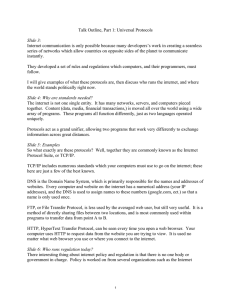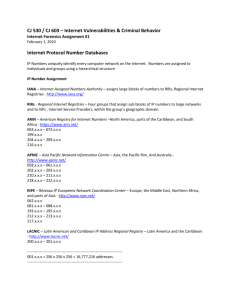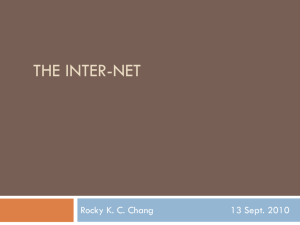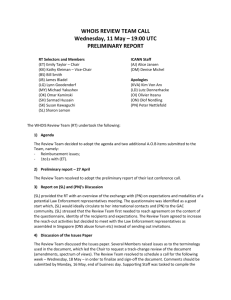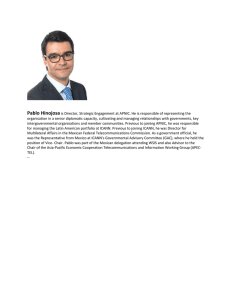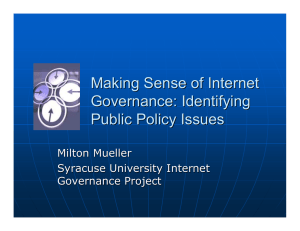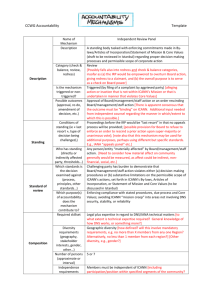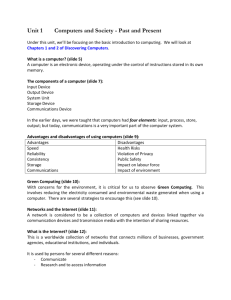Protocols and Governance Presenter – Ian Peter
advertisement
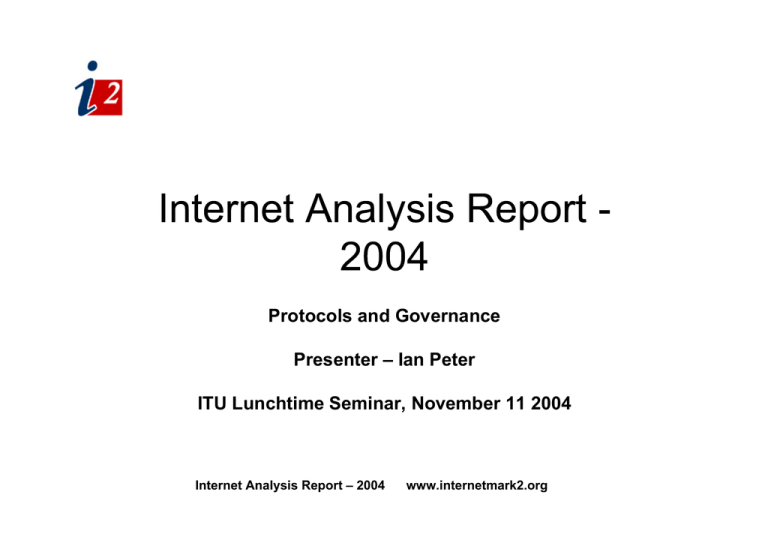
Protocols and Governance Presenter – Ian Peter ITU Lunchtime Seminar, November 11 2004 Internet Analysis Report – 2004 www.internetmark2.org • Internet is getting older and bigger • It does not appear to be handling all current user requirements • It was designed for another purpose altogether • Protocols first described as legacy systems in 1990 • Lack of traditional business analysis in looking at problem Internet Analysis Report – 2004 www.internetmark2.org • Base protocols invented in 1970s and 1980s for different purpose altogether – timesharing between computers • Original purpose did not foresee – – – – – – The development and use of personal computers Use of phones and portable devices Broadband networks and processing power A network to be used for commercial purposes People communicating with each other World wide web • Are these protocols still appropriate? Internet Analysis Report – 2004 www.internetmark2.org • High incidence of viruses and worms • Rapidly developing lack of trust because of fraudulent activity • Clogging of email systems with spam • Usage outside of societal norms • Perceived slowness • Availability and affordability issues • Capacity to communicate in own language Are these issues being dealt with effectively? (the internet wasn’t designed to deal with any of these issues….) Internet Analysis Report – 2004 www.internetmark2.org • Structures arise from original purpose • Structures retained by habits (cow tracks) • In expanding we (and the cows) normally follow path of least resistance • But you can’t build a multi-storey hotel on the foundations of a cottage Internet Analysis Report – 2004 www.internetmark2.org • Structure affects behaviour • When power=structure, energy is directed to maintaining structure rather than serving needs of stakeholders • Sometimes a change of structure is the easiest course to change • A compelling reason for change has to exist • A compelling reason for change has to be communicated • Change and transition management is a science • Stakeholder analysis is a first step Internet Analysis Report – 2004 www.internetmark2.org • What was original purpose of the structures we are examining? • Have user needs changed? • Are current structures appropriate for todays purposes? • What can we recycle from existing structures in creating tomorrow’s Internet? Internet Analysis Report – 2004 www.internetmark2.org • • • • • • Introduction Problem definition and issues User requirements Relevant history Protocol analysis Governance analysis Internet Analysis Report – 2004 www.internetmark2.org • Involved with Internet since 1986 • Co-founder, Association for Progressive Communications • Member Editorial Board, First Monday • Member of .ORG Advisory Council • Management and Change Management consultancy • Internet history – www.nethistory.info Internet Analysis Report – 2004 www.internetmark2.org • • • • • • • UNEP, UNCED ICANN APNIC Telstra, Nortel ABC-TV Commonwealth of Australia State of Queensland Whole of government portal Internet Analysis Report – 2004 www.internetmark2.org The Internet is for everyone • The Internet of the future must be – – – – – – – – – – – Trustworthy Reliable Globally inclusive Vendor neutral Easy to use Affordable Able to change rapidly Innovative and capable of significant expansion Transparently and well managed Involving industry, government and community stakeholders What do we have when we create this? Internet Analysis Report – 2004 www.internetmark2.org • Many voices, one world • The right to communicate in an age of mass media • The importance of free flow of information • TCP/IP and DNS are only useful if relevant to higher purpose Internet Analysis Report – 2004 www.internetmark2.org • A unique medium and a puzzle for regulators – neither broadcast nor communications in a traditional sense • Size, scale and speed – from 600 million to 6 billion • Global inclusiveness – the IDN issue • ENUM and convergence • Wireless and mobility • Peer to Peer – many to many • Illegal software, music piracy, pornography • Affordability and availability as a human rights issue Internet Analysis Report – 2004 www.internetmark2.org • Comprehensive business analysis , as an aid to developing future directions and strategies • A factual document to guide thinking about future directions • Investigate major user requirements for a 21st century Internet • Analyse whether current Internet is capable of meeting these objectives Internet Analysis Report – 2004 www.internetmark2.org Concentrating on: • TCP/IP (1970s) Transport Control Protocol/Internet Protocol • DNS and WHOIS (1980s) Domain Name System • SMTP (1970s) Simple Message Transfer Protocol • Adjust, amend, replace, pave over? Internet Analysis Report – 2004 www.internetmark2.org • Transmission Control Protocol and Internet Protocol • Invented 1973 • Added to Arpanet 1983 • OSI wars and different networks • Adopted as path of least resistance in early 1990s • Running out of numbers (perceived) – 1990s • The slow TCP/IPv4 TCP/IPv6 upgrade Internet Analysis Report – 2004 www.internetmark2.org • • • • • • Traffic prioritisation Unsuitability for financial transactions Stalled IPv6 adoption Security issues Performance issues particularly with higher speeds Do these protocols make sense for current needs? Summary – TCP at least should be replaced in 5-7 year timeframe Internet Analysis Report – 2004 www.internetmark2.org • The world’s largest distributed database • Originally to allow computers and operators to find each other easily • WHOIS database stores names and addresses of domain owners and contacts • DNS maps names and hosts of websites to numbers • No equivalent in telephony Internet Analysis Report – 2004 www.internetmark2.org • Cannot handle multiple languages (the ascii vs unicode problem) • Language is effective for computer-computer (original design) but not human-human (the modern communication need) • Refresh rates and size • Use of domain names for branding • Paradoxical centralised architecture • Whois and privacy • Security and DNSSec • Domain name legal and IP issues • Consequences of original design purposes for another structure Internet Analysis Report – 2004 www.internetmark2.org • Email is broke. According to Pew and others – – – – – 25% of users lessening use because of spam volume 70% of users adversely affected by spam 30% believe filtering could cause loss of mail 76% bother by offensive content 80% bothered by deceptive or dishonest content Annual cost between $10 and $87 billion Internet Analysis Report – 2004 www.internetmark2.org Designed for an honest age within structure of computer timesharing “like borders without passports or bank vaults without locks” Issues • Anyone can pretend to be anyone • Forgery is simple • Mass marketability • Mass of competing protocols • Old systems not upgraded – backwards compatibility Internet Analysis Report – 2004 www.internetmark2.org Yes, but, • ICANN says it’s out of scope “issues of concern to Internet users, such as the rules for financial transactions, content control, unsolicited commercial email (spam) and data protection are outside of the range of ICANN’s mission of technical co-ordination” • IETF cannot address the issue effectively (see MARID case study later in this presentation) Internet Analysis Report – 2004 www.internetmark2.org • ASPEN formula – Authentication, Accreditation, Reputation • Industry collaboration • New standards • Cf Web and email • Pave over SMTP? Internet Analysis Report – 2004 www.internetmark2.org Major issues exist in scaling to future. More research needed on most appropriate approaches to reform/migration. Patent issues. Change management issues are significant. Project structures are recommended. Internet Analysis Report – 2004 www.internetmark2.org • Evolutionary rather than structural • Evolved from structures to serve obsolete purposes • Inter-related bodies • Volunteerism – – – – “Eccentric in structure” “Illogical in scope” “Incomplete in terms of Internet governance” Why… Internet Analysis Report – 2004 www.internetmark2.org • Self-governing standards organisations (ITU, IETF, W3C, IEEE, OASIS etc) • Self-governing Regional Internet Registries (APNIC, RIPE, ARIN etc) (RIRs/NROs/ASOs) • Self-governing root server operators • ccTLDs (see separate slide) None of these are the subject of the ICANN/US Government contract. Root servers have separate contract with DOC, others have none. Internet Analysis Report – 2004 www.internetmark2.org Internet Engineering Task Force • One of three more central standards bodies (others are ITU and W3C) • Founded in 1986 • No Board of directors, no members, no dues • loosely self-organised group of people • A classic technocracy • Evolved from “smoke filled room” • Needs to change structure rather than make changes within structure Internet Analysis Report – 2004 www.internetmark2.org • • • • • • • • • • • • Having difficulties adopting to larger size No clear definition of mission Unsure what it is trying to achieve Unsure who its stakeholders are Cannot prioritise actions effectively Loses sight of overall architecture Change management rarely managed Standard project management rarely followed Long timeframes Poor takeup of standards No user input mechanism Difficulty with complex and large scale problems Internet Analysis Report – 2004 www.internetmark2.org • IPv6 – Began 1991 – Ready to implement 1996 in scaled down version – Added to root 2004 • DNSSec – Need obvious in 1990 – IETF work began 1995 – May be ready for deployment in 2005 • MARID (see over) Internet Analysis Report – 2004 www.internetmark2.org • • • • • • • IETF’s first major effort in addressing spam problems Began 2004 when it was obvious industry was going to do something Merging of Microsoft proposal with open source proposal for sender authentication (Sender ID) Microsoft lodged defensive patents covering wide range of related activities “IANAL” – no-one knew what to do Workgroup disbanded Some hope, but…. Very few issues are technical only. When non-technical issues arise IETF has no means to determine policy direction. Internet Analysis Report – 2004 www.internetmark2.org • • • • Related standards organisations Different models for governance structures Work with IETF as appropriate Need to govern more than technical standards Internet Analysis Report – 2004 www.internetmark2.org • Root server operators report direct to US government, not through ICANN • Regional Internet Registries (RIRs) established before ICANN and US Government control and retain large degree of independence through Number Resource Organisation (NROs) • Effective regional stakeholder involvement in RIRs. Internet Analysis Report – 2004 www.internetmark2.org • Originally individuals in technical community • In some cases now controlled by governments or in association with governments • Some remaining techno neo-colonialism • Role of governments varied and unclear Internet Analysis Report – 2004 www.internetmark2.org • Corporation under US Law • Operates under contract with DOC (US Government) • “Advisory Committee to US Govt?” • Various MOUs with other associated bodies • States that it is a “technical co-ordination body” Internet Analysis Report – 2004 www.internetmark2.org • Regulates competitive environment in DNS • Establishing UDRP (Uniform Dispute Resolution Policy) and its role in intellectual property issues • Anything else suggested under DOC contract Internet Analysis Report – 2004 www.internetmark2.org • • • • • Active in intellectual property areas Active in security areas Active on privacy issues Inactive on consumer protection Inactive on spam How effective has ICANN been on public policy areas it has been involved in? (WHOIS case study) Internet Analysis Report – 2004 www.internetmark2.org • What we have is – Eccentric in structure – Illogical in scope – Incomplete in coverage • WSIS is appropriate forum to determine what is needed • Structures need to be appropriate to purposes and user requirements • Don’t throw away what made it grow – openness, low cost of participation Internet Analysis Report – 2004 www.internetmark2.org • Create even base of knowledge of issues among stakeholders • Examine interdependencies between protocol reform and governance • Awareness raising • State of Messaging Report • Further work on approaches to protocol reform Internet Analysis Report – 2004 www.internetmark2.org "excellent work - a good and informative paper“ "very clear and insightful“ "lays out its case in simple, understandable terms“ "what I found valuable about it was the breadth of the approach, introducing readers to a wide range of barriers that the Internet faces in increasing the breadth and depth of its current coverage" Internet Analysis Report – 2004 www.internetmark2.org • • • • • Go to www.internetmark2.org Order form available today Credit card bookings on line Purchase Orders ***** Special discount***** Internet Analysis Report – 2004 www.internetmark2.org Email: ian.peter@ianpeter.com Internet Analysis Report – 2004 www.internetmark2.org
